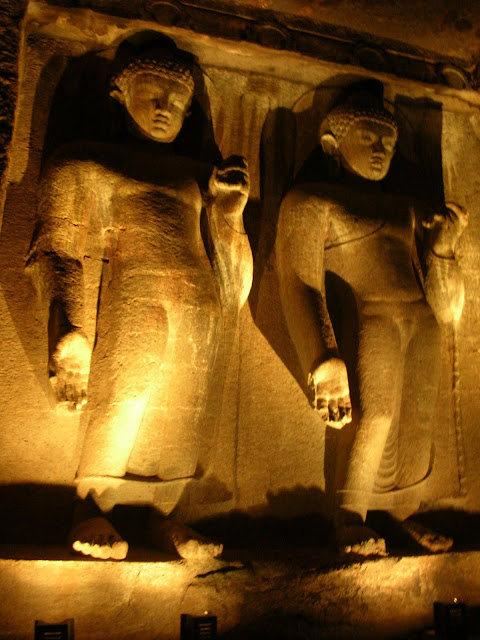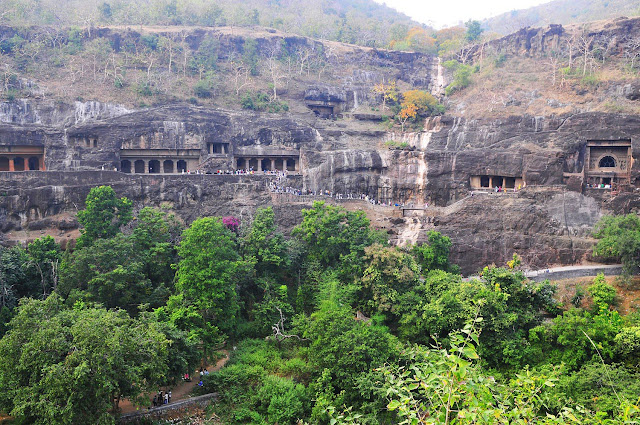The first Buddhist cave monuments at Ajanta date from the 2nd and 1st centuries B.C. During the Gupta period (5th and 6th centuries A.D.), many more richly decorated caves were added to the original group. The paintings and sculptures of Ajanta, considered masterpieces of Buddhist religious art, have had a considerable artistic influence.
The style of Ajanta has exerted a considerable influence in India and elsewhere, extending, in particular, to Java. With its two groups of monuments corresponding to two important moments in Indian history, the Ajanta cave ensemble bears exceptional testimony to the evolution of Indian art, as well as to the determining role of the Buddhist community, intellectual and religious foyers, schools and reception centres in the India of the Gupta and their immediate successors.
 |
| Ajanta Caves, India |
The caves are situated 100 km north-east of Ellora, 104 km from Aurangabad and 52 km from Jalgaon Railway Station. They are cut into the volcanic lava of the Deccan in the forest ravines of the Sahyadri Hills and are set in beautiful sylvan surroundings. These magnificent caves containing carvings that depict the life of Buddha, and their carvings and sculptures are considered to be the beginning of classical Indian art.
The 29 caves were excavated beginning around 200 BC, but they were abandoned in AD 650 in favour of Ellora. Five of the caves were temples and 24 were monasteries, thought to have been occupied by some 200 monks and artisans. The Ajanta Caves were gradually forgotten until their 'rediscovery' by a British tiger-hunting party in 1819.
The Ajanta site comprises thirty caves cut into the side of a cliff which rises above a meander in the Waghora River. Today the caves are reached by a road which runs along a terrace mid-way up the cliff, but each cave was once linked by a stairway to the edge of the water. This is a Buddhist community, comprising five sanctuaries or Chaitya-grihas (caves 9, 10, 19, 26 and 29) and monastic complex sangharamas or viharas. A first group of caves was created in the 2nd century BC: the chaitya-grihas open into the rock wall by doorways surmounted by a horse-shoe shaped bay. The ground plan is a basilical one: piers separate the principal nave from the side aisles which join in the apsis to permit the ritual circumambulation behind the (commemorative monument). This rupestral architecture scrupulously reproduces the forms and elements visible in wooden constructions.
A second group of caves was created at a later date, the 5th and 6th centuries AD, during the Gupta and post-Gupta periods. These caves were excavated during the supremacy of the Vakatakas and Guptas. According to inscriptions, Varahadeva, the minister of the Vakataka king, Harishena (c. AD 475-500), dedicated Cave 16 to the Buddhist sangha while Cave 17 was the gift of the prince, a feudatory. An inscription records that the Buddha image in Cave 4 was the gift of some Abhayanandi who hailed from Mathura.
The earlier architectural formulas were re-employed but treated in an infinitely richer and more ample manner. The decoration attained, at this time, an unequalled splendour: the statuary is numerous (it was already permissible to represent Buddha as a human; these representations are found both on the facades and in the interior). Finally, the wall painting, profuse and sensitive, constitutes, no doubt, the most striking artistic achievement of Ajanta.
Under the impulse of the Gupta dynasty, Indian art in effect reached its apogee. The Ajanta Caves are generally decorated with painted or sculpted figures of supple form and classic balance with which the name of the dynasty has remained synonymous. The refined lightness of the decoration, the balance of the compositions, the marvellous beauty of the feminine figures place the paintings of Ajanta among the major achievements of the Gupta and post-Gupta style and confer on them the ranking of a masterpiece of universal pictorial art.
(Text Content Source:- Wikipedia. Images Source:- Wikimedia, Google, Picasa, Bing, Yahoo, Flickr & etc….)
(Images are copyrighted by their owners. All are free images, taken from the web with the consent of owners who they approved to download it, and any copyright issues found by any image owners, contact the administrator immediately.)





































Great information on several world heritage sites of across the globe. Fantastic and fabulous information.
ReplyDeletePlease look into my Heritage of India blog. In my Heritage of India i am exploring and sharing Indian Heritage and Culture in various aspects with my own collections and also other people collections with their permission.
http://indian-heritage-and-culture.blogspot.in/
Please give your opinion about my Heritage of India blog. Shall i sue your indian photos on Ajanta and other themes in my blog.
Please reply.
Excellent blog with great information on World Heritage Sites. Your blog contains valuable information.
ReplyDeletePlease look into my Heritage of India blog. In my blog i am exploring and sharing Indian Heritage and Culture in various aspects from my own collections and and also using other people collections with their permission.
http://indian-heritage-and-culture.blogspot.in/
Please look into my blog and share your comments about my blog. Shall i use your indian related information and pictures in my Heritage of India blog.